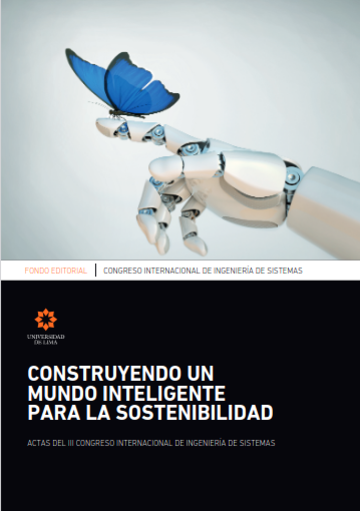Detection of SARS-CoV-2 in Chest X-Rays by Means of Mid-Level Image Descriptors and Machine Learning Techniques
DOI:
https://doi.org/10.26439/ciis2020.5505Keywords:
COVID-19, machine learning, deep learning, computer vision, mid-level image descriptorsAbstract
COVID-19, the disease caused by the SARS-CoV-2 and originated in the Chinese city of Wuhan, has quickly spread around the world. To date, there have been more than 36,738,525 confirmed cases worldwide. Rates of COVID-19 cases increase on a daily basis and access to healthcare is not enough. For these reasons, a series of methods have been propo sed to identify the novel coronavirus faster and at lower cost. An example of said methods is COVID-NET, a convolutional neural network that identifies COVID-19, pneumonia or normal lungs. This research proposes a methodology to identify and classify chest X-ray images according to three categories: COVID-19, pneumonia or normal lungs. To that end, mid level image descriptors were employed: HOG+PCA, SIFT+K-means and SURF+K-means, combined with a SVM classifier. In addition, three CNN structures were used: VGG19, DenseNet121 and MobilNetV2. The COVIDx3 dataset, consisting of 15,746 chest X-rays, was used. Good results were obtained, where MobilnetV2 plus data augmentation showed the best performance, with a recall of 0.97 for the COVID-19 class, and an average precision and recall of 0.92 and 0.91, respectively. Given the current COVID-19 health crisis, this approach may be used for detecting the virus and as a reference for future research.
Downloads
References
Apostolopoulos, I. D., y Mpesiana, T. A. (2020). COVID-19: Automatic Detection from X-Ray Images Utilizing Transfer Learning with Convolutional Neural Networks. Physical and Engineering Sciences in Medicine, 43(2), 635-640. https://doi.org/10.1007/s13246-020-00865-4
Bay, H., Tuytelaars, T., y Van Gool L. (2006). SURF: Speeded Up Robust Features. ECCV 2006. 3951, 404-417. 10.1007/11744023_32
Cohen, J. P., Morrison, P., y Dao, L. (2020). COVID-19 Image Data Collection: Prospective Predictions Are the Future. https://arxiv.org/pdf/2003.11597.pdf
Bell et al.(s. f.). COVID-19. https://radiopaedia.org/articles/covid-19-4
Dalal, N., y Triggs, B. (2005). Histograms of Oriented Gradients for Human Detection. IEEE Computer Society Conference on Computer Vision and Pattern Recognition (CVPR’05). 1, 886-893. 10.1109/CVPR.2005.177
European Society of Radiology. (2020). COVID. https://www.eurorad.org/advanced-search?search=COVID
Gao, H., Zhuang, L., van der Maaten, L., y Weinberger, K. (2018). Densely Connected Convolutional Networks. https://arxiv.org/pdf/1608.06993.pdf
Lowe, D. (2004). Distinctive Image Features from Scale-Invariant Keypoints. InternationalJournal of Computer Vision, 60, 91-110. https://doi.org/10.1023/B:VISI.0000029664.99615.94
Oh, Y., Park, S., y Ye, J. C. (2020). Deep Learning COVID-19 Features on CXR Using Limited Training Data Sets. IEEE Transactions on Medical Imaging, 39(8), 2688-2700. https://doi.org/10.1109/TMI.2020.2993291
Radiological Society of North America. (Octubre del 2018). RSNA Pneumonia Detection Challenge [Dataset]. https://www.kaggle.com/c/rsna-pneumonia-detection-challenge
Rahman, T., Chowdhury, M., y Khandakar A. (Marzo del 2020). COVID-19 Radiography [Dataset]. https://www.kaggle.com/c/rsna-pneumonia-detection-challenge
Sandler, M., Howard, A., Zhu, M., Zhmoginov, A., y Chen L. (2018). MobileNetV2: Inverted Residuals and Linear Bottlenecks. IEEE/CVF Conference on Computer Vision and Pattern Recognition, 4510-4520. 10.1109/CVPR.2018.00474
Simonyan, K., y Zisserman, A. (2014). Very Deep Convolutional Networks for Large-Scale Image Recognition. https://arxiv.org/pdf/1409.1556.pdf
Società Italiana di Radiologia Medica e Interventistica. (2020). COVID-19 Database. https://www.sirm.org/category/senza-categoria/COVID-19/
Wang, L., Wong, A., Qiu Lin, Z., McInnis, P., Chung, A., y Gunraj, H. (2020). Actualmed COVID-19 Chest X-Ray Dataset Initiative [Dataset]. https://github.com/agchung/Actualmed-COVID-chestxray-dataset
Wang, L., Qiu Lin, Z., y Wong, A. (2020). Figure 1 COVID-19 Chest X-Ray Dataset Initiative. https://github.com/agchung/Figure1-COVID-chestxray-dataset
Wang, L., Qiu Lin, Z., y Wong, A. (2020). COVIDx Dataset (version 3) [Dataset].
https://github.com/lindawangg/COVID-Net/blob/master/docs/COVIDx.md
Wang, L., y Wong, A. (2020). COVID-Net: A Tailored Deep Convolutional Neural Network Design for Detection of COVID-19 Cases from Chest X-Ray Images. arXiv preprint arXiv:2003.09871.
Wang, W., Xu, Y., Gao, R., Lu, R., Han, K., Wu, G., y Tan, W. (2020). Detection of SARS-CoV-2 in Different Types of Clinical Specimens. Jama, 323(18), 1843-1844.
World Health Organization. (9 de octubre del 2020). WHO Coronavirus Disease (COVID-19) Dashboard. https://covid19.who.int/?gclid=CjwKCAjw_Y_8BRBiEiwA5MCBJhROPzfziFPFQFT_QltAEQ_F29AGq Jd21iBevf HeHeVvQCSxUJJJbhoCowwQAvD_BwE


